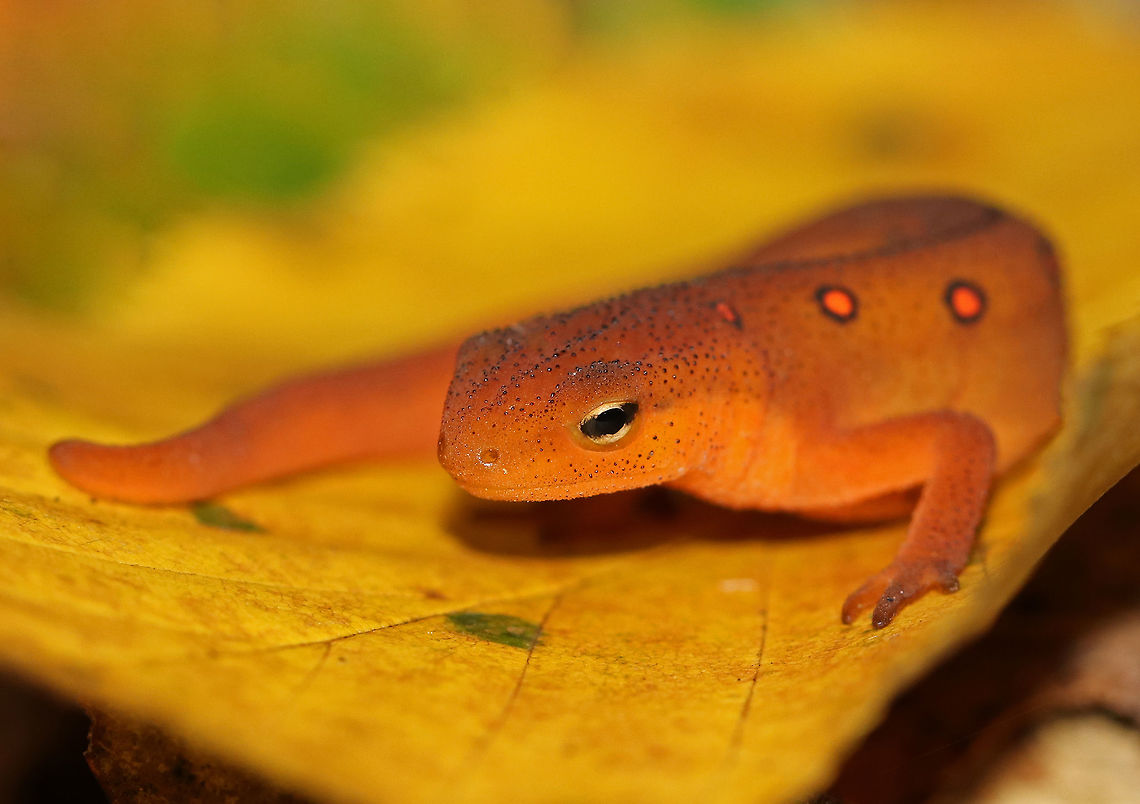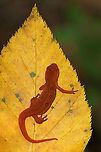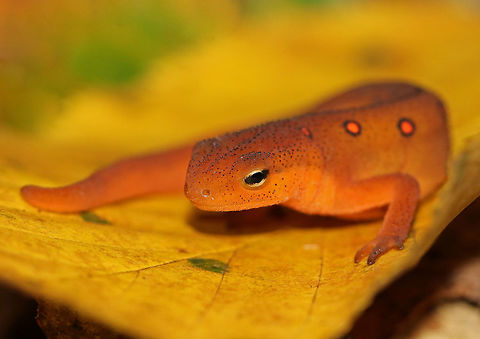 Promoted
Promoted
Eastern Newt (Red Eft) - Notophthalmus viridescens
Red efts have bright orange aposematic coloring, with darker, reddish spots outlined in black. This stage can last up to 4 years on land, during which time efts may travel far, which ensures outcrossing in the population. Efts eat small insects, snails, and other small arthropods. During winter, they hibernate under logs or rocks.
Habitat: Spotted in a mixed forest.


The eastern newt or red-spotted newt is a common salamander of eastern North America. Eastern newts dwell in wet forests with small lakes or ponds. They can coexist in an aquatic environment with small, non-carnivorous fish, however, their skin secretes a poisonous substance when the newt is threatened or injured. They have a lifespan of 12 to 15 years in the wild, and may grow to 5 inches in length.

comments (24)
And, I just deleted myself! Posted 7 years ago
"The Eastern newt (Notophthalmus viridescens) is a species of salamander found in eastern North America. It experiences a 3-stage life cycle: (1) the aquatic larval stage, (2) the terrestrial (juvenile) eft stage, and (3) the aquatic adult stage. This vibrant individual has entered the second life stage or the juvenile (eft) stage. This stage typically begins in late summer to early fall, when the larva sheds its gills and departs from its aquatic habitat, seeking out food and hibernation locations under logs, rocks, or soil.
This red eft's striking red to orange color is a prime example of aposematic coloration, which serves in this case as a conspicuous warning to potential predators that there is an unpalatable and potentially deadly neurotoxin called tetrodotoxin within. The Eastern newt produces this toxin during all life stages, but the concentration is at its greatest during the red eft stage.
After maturation, the red eft will eventually return to its aquatic habitat and undergo a second metamorphosis in which its skin returns to a green or brown color. It is during this aquatic adult stage that reproduction occurs. The aforementioned red eft stage can last up to 7 years, while the Eastern newt's total lifespan can reach up to 15 years!
Eastern newts are not currently listed under a special conservation status but are thought to be on the decline as a result of anthropogenic habitat fragmentation. Additionally, polluted waters and acid rain are thought to have led to an increase in the rates of viral, bacterial, and fungal diseases in this species.{Spotted in Connecticut, USA by JungleDragon moderator, Christine Young} #JungleDragon" Posted 7 years ago
Did you know that the week of May 1-7th has been designated as International Amphibian Week?? The aim is to bring awareness to these amazing creatures and their plight as they face habitat loss, pollution, disease, and ultimately species' decline.
Amphibians include frogs, caecilians, and salamanders. They are fascinating, beautiful, diverse, and have important roles in their ecosystems. Take some time to educate yourself about these incredible creatures! #JungleDragon #amphibianweek2022 #amphibianweek
Check out these links for more information:
https://www.amphibians.org/amphibianweek/
https://www.amphibians.org/who-we-are/why-amphibians/
To see more photos of amphibians:
https://www.jungledragon.com/.../animalia/chordata/amphibia
https://www.facebook.com/jungledragonwildlife
Instagram: @jungledragonwildlife Posted 3 years ago